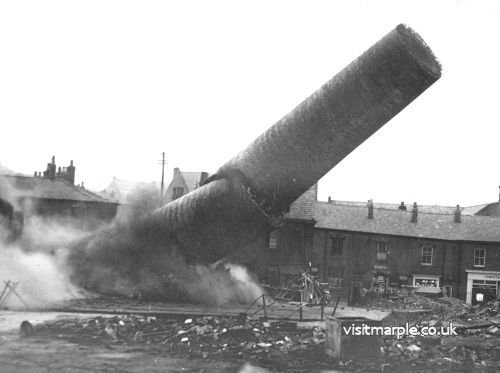The Union Rooms Marple: From 1870s to 2020
Marple Union Rooms/Regent Cinema:
A tale of temperance, coffee at penny a cup, a church army, a falling chimney, not to mention the ‘flicks’.
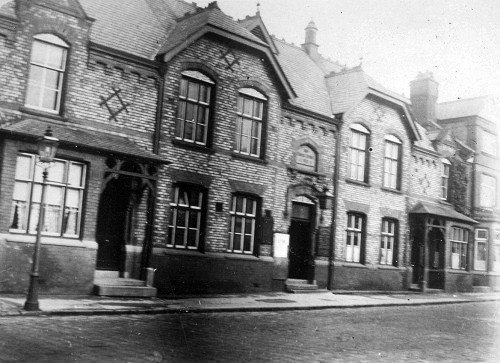
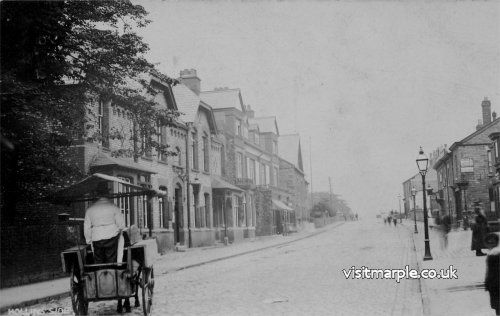 Union Rooms on left, looking towards the NavigationDominating the centre of Marple for over 120 years, Hollins Mill and its owners lead us into the history of the Union Rooms. In 1863 the mill was sold, by Charles Walmsley to the Carver and Hodgkinson families. Staunch Congregationalists, they helped in the acquisition of land and the building of the Congregational Church on Hibbert Lane. But in 1876, when a disagreement arose, Thomas Carver parted company with the church. He announced his plan to establish “An un-sectarian meeting room where Christians of all denominations may meet", a union of all denominations. Hence the name the ‘Union Rooms’? This was achieved by erecting the Union Rooms, on land adjacent to the entrance drive of the Carver’s family home, Hollins House. The building was centrally heated and included a reading room, an assembly/mission room and a coffee tavern; this last feature represents Thomas’ hope to draw the working men away from the ‘evil drink’. Alcohol consumption was rising nationally and peaked in the 1870s. Temperance movements emerged which sought to restrict the use of drink in various ways. Whether the building would have materialised without the rift, we may never know.
Union Rooms on left, looking towards the NavigationDominating the centre of Marple for over 120 years, Hollins Mill and its owners lead us into the history of the Union Rooms. In 1863 the mill was sold, by Charles Walmsley to the Carver and Hodgkinson families. Staunch Congregationalists, they helped in the acquisition of land and the building of the Congregational Church on Hibbert Lane. But in 1876, when a disagreement arose, Thomas Carver parted company with the church. He announced his plan to establish “An un-sectarian meeting room where Christians of all denominations may meet", a union of all denominations. Hence the name the ‘Union Rooms’? This was achieved by erecting the Union Rooms, on land adjacent to the entrance drive of the Carver’s family home, Hollins House. The building was centrally heated and included a reading room, an assembly/mission room and a coffee tavern; this last feature represents Thomas’ hope to draw the working men away from the ‘evil drink’. Alcohol consumption was rising nationally and peaked in the 1870s. Temperance movements emerged which sought to restrict the use of drink in various ways. Whether the building would have materialised without the rift, we may never know.
A contemporary report on the opening of Maple’s new facility of 1878.
THE UNION ROOMS AND COFFEE TAVERN, MARPLE.
(Hyde & Glossop Weekly News, and North Cheshire Herald - Saturday 02 November 1878)
A view on Stockport Road from the Navigation, looking towards the Union Rooms (Regent Cinema) believed to be at the time of Edward VII's coronation in 1902.The above rooms, which have been built by Mr. Thomas Carver, of Marple, especially for the benefit of the public, have been fitted up regardless of expense for the comfort and convenience of all who may use them. The heating apparatus, which is of the latest patent, has been fitted by G. N. Haden and Son, engineers, Trowbridge, Wiltshire. It is placed in the cellar, and so arranged that every room can be heated as required, and if the heat be too great it can gradually be shut off. The assembly room is well fitted with seats, and there is a nicely arranged platform; the windows are neatly corniced and curtained. Adjoining there is a well appointed committee or retiring room and other conveniences. The Coffee Tavern is a splendidly fitted up apartment; it has seats, tables, etc. The bar is a very attractive structure, with coffee, cocoa, and tea stands, the liquids from which will be retailed at a penny per cup. The reading-room is an admirably-arranged apartment, and has a desk for the use of speakers or readers if needed. There are lavatories, closets, etc. The cellar, in which the heating apparatus, gas meters, etc. are fixed, can be used as a store room. There are houses for the caretakers and waiters, cooking apparatus, etc. as required. The fittings, such as furniture, etc. have been supplied by Messrs. Heaps and Harrison, of Manchester, and the bar requisites from a Liverpool firm. All are worthy the name of the makers. The room ought to be well patronised, and become a boon to the public.
After a while the services began to lose their appeal, but in contrast, the Coffee Tavern proved to be a great success. Weekends brought religious groups crowding into the village, with Sunday Schools' outings popular at the time. In April 1887 it was reported that "200 people from Miles Platting took the total for the weekend to over 500 dinners with tea provided by Mr. Webb to excursionists".
Taking his lead from the Salvation Army, formed in 1878, Thomas Carver tried to bolster religious attendance at the Rooms by forming the Union Rooms Mission Army. This platoon marched through Marple on Sundays, resplendent in their dark blue uniforms, led from the front by General Carver. The disastrous fire at Mellor Mill in November 1892 affected the whole of Marple and the Union Rooms were not exempt. Many of the redundant millworkers left the area; the core of Carver’s army was lost. They had disbanded by 1898.
Following the death of Thomas Carver, in 1910, the Marple Congregational Church took charge of the Rooms. This arrangement lasted some 20 years. During this time services were held in the Mission Room, but by the end of the period, care of the building was proving difficult, financially. The building was about to enter the second stage of its life.
second stage of its life.
Up for sale, one proposal was refused. In 1929 Walter Stott, ex-proprietor of Marple’s Gem cinema proposed to erect “The Rialto” cinema on the site, subject to the granting of a cinema and music licence,. "It would" he claimed "be a steel framed, fire proof structure, it would have a good appearance with two shops at the side and would accommodate 680 persons". The design used was by architect William Thornley, who built the Stockport Plaza in 1932. It is thought the there was insufficient finance for the plan.
Two years later approval was granted for another plan. This was by Ernest G Allen, the new owner of the property, for the conversion of the Union Rooms and three adjoining houses on Stockport Road to the “Regent Cinema”, with 545 seats. Structural changes were to a design by R.W. Samson of Sheffield, for the Marple Cinema Company. This new venture was to be managed by Mr. Ray Taylor, who also managed the Arts Cinema in New Mills. Fitted with British Thompson-Houston Sound Equipment the cinema opened at 6.45p.m. on Monday 22nd August 1931. The packed house enjoyed watching Renate Müller, Jack Hulbert and Owen Nares in 'Sunshine Susie'. Prices for the opening bill were: Stalls 7d & 9d and Circle 1/- & 1/3d. (Those of you not old enough to remember, that's roughly 3p, 4p, 5p & 7p respectively).
TV viewing took hold of the nation in the late 1950s and through the 1960s. This caused many cinemas to close, though the Regent survived, just!
'Blaster' Bates takes out the Hollins Mill Chimney in 1957
In 1954, the English Sewing Company transferred production from Hollins Mill to Matlock Bath and Portwood. This caused two hundred and seventy people to lose their jobs. From May 1954, machinery was removed. In January 1957 the spinning portion of the mill that fronted onto Hollins Lane and Stockport Road was demolished, together with some of the weaving sheds.
The final act came on the 25th of October 1957. The chimney which had been reduced to ninety feet by steeple jacks, was blown up by 'Blaster' Bates.
A newspaper reported:
‘Five pound of high explosive, skilfully detonated within a few feet of the pavement of Stockport Road...literally blasted the remains of Hollins Mill chimney off its feet...It was like carnival day in Marple, the widely publicised event drawing a crowd of over four thousand people by bus, train and on foot...there was an ear splitting crash as 18 simultaneous fused charges’
As this happened to the last remains of once Thomas Carvers mill, the matinee was stopped at the Regent, the children flocked from the once Thomas Carver Union Rooms aka Regent Cinema to see the fall of the chimney.
But by the later 1960s it was in a sad state of repair, being run by Ray Taylor, a well-known local character. Lynda Jenkins and Christine Julier both recall going to the Saturday afternoon matinee and Mr. Taylor stopping the film because of the noise the children were making (shouting, stamping feet etc.). He used to stop the film and come to the front and shout at the children to shut up. If they didn’t comply, and of course they didn’t, he used to open the side doors and chuck everyone out. Eventually, he would let some but not all of the children back in. Later in its final days it was managed by Lawrence Corbett who was also the projectionist, boiler-man and caretaker. On the 3rd August 1968 the Regent finally closed its doors and was put up for sale.
The first move in this new stage of the Union Rooms history was an application to turn the building into a bingo hall. What would have Thomas Carver have thought? Marple UDC decided on 10th February 1969 that to grant approval as a Bingo Hall would be "injurious to the amenities of the area" and “that the change would cause an increase in traffic and consequently cause a traffic hazard”. The application was refused.
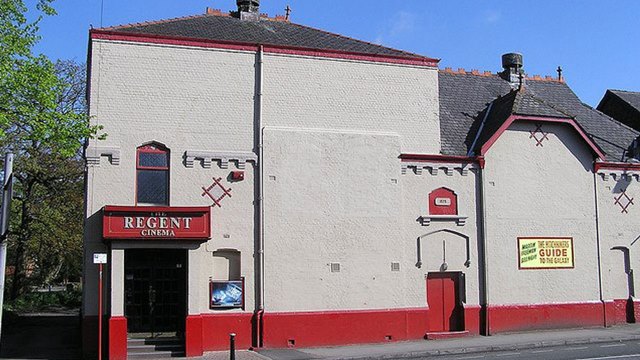 At this point the Council decided to try and buy the premises, applying for a Compulsory Purchase Order, with the plan to turn it into a community centre. But on 12th June the council withdrew their application, as Mr. James Lillis made an application for the renewal of the cinema license. David Lillis, Jame’s son, helped in the reopening of the cinema in June 1969. He had experience of cinema management with ABC Cinemas. Pullman seats were installed in the circle and new seats too in the stalls together with redecoration of the interior and new carpets. The renovated cinema had a seating capacity of 252. Until four years ago they also ran a twin cinema in Matlock, with David in charge. But after it's closure David helped his father at the Regent, taking over the managment following Jame's death. It has become a popular destination for discerning cinema goers to visit - those who wish to enjoy the latest blockbusters in a venue that has both character, and an interval in which to enjoy an ice-cream.
At this point the Council decided to try and buy the premises, applying for a Compulsory Purchase Order, with the plan to turn it into a community centre. But on 12th June the council withdrew their application, as Mr. James Lillis made an application for the renewal of the cinema license. David Lillis, Jame’s son, helped in the reopening of the cinema in June 1969. He had experience of cinema management with ABC Cinemas. Pullman seats were installed in the circle and new seats too in the stalls together with redecoration of the interior and new carpets. The renovated cinema had a seating capacity of 252. Until four years ago they also ran a twin cinema in Matlock, with David in charge. But after it's closure David helped his father at the Regent, taking over the managment following Jame's death. It has become a popular destination for discerning cinema goers to visit - those who wish to enjoy the latest blockbusters in a venue that has both character, and an interval in which to enjoy an ice-cream.
Having occupied the building from 1969 to the present date, the New Regent represents the longest single use of the site since Thomas Carver turned over the first sod of earth, circa 1876.
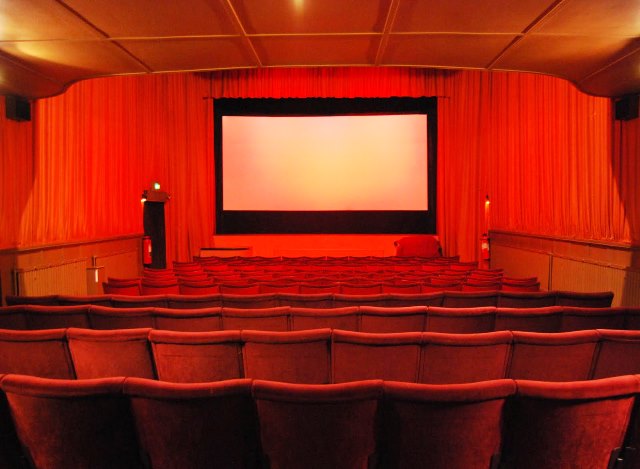
Regent Interior 2011
But It’s not the threat of bingo(!) or those binge box sets that at the time of writing has closed the cinema, but that well known bug Covid-19. Once again the Union Rooms/Regent is moving onto a new page in its history.
Recently an online crowdfunding page raised £8,231, in eight weeks, for the Regent Cinema and Carver Theatre. The latter is of course connected to Carver family, built by Oswald Carver, Thomas’ son.
Footnotes:
Coffee Tarvens - not just in Marple
The Temperance Movement was at the height of its influence and membership in the 1880s. This was a society that condemned alcohol as the root of the problems of poverty and destitution. They bought up restaurants and music halls, trying to recreate the atmosphere of the coffee houses of the 16th century. Working men were encouraged to visit establishments that provided teetotal entertainment as an alternative to the many public houses which were widely blamed for causing drunkenness and ill-health amongst the working-class people.
At a meeting in November 1878, at the Union Rooms, it was reported of Thomas Carver that: "He described the origin of the Coffee Tavern movement, which was first mooted when Mr. D. L Moody was in LiverpooL About two years ago there was only one, now thero were 34 Coffee Taverns in various parts of that seaport."
Cinemas in Marple
Marple's first regular film shows were held at the Shepley Hall, now the Conservative Club, on Church Lane. A cinematograph licence was granted to James Rolmaz in July 1911, and the hall was later run by Henry Lawrence. In August 1915 Lawrence moved from the Shepley Hall to new premises in Church Lane, which he called the Gem cinema. The Shepley Hall was later used for occasional film shows. By all accounts the Gem was a primitive, mostly wooden structure, with the seating consisting largely of wooden benches. It was at the junction of Church Lane/Hibbert Lane, later becoming the GPO building, after the site was occupied by Marple Metal Products Star Sign Engineering Works from circa 1939 -1945. The Gem survived until the arrival of talking pictures under a number of proprietors. These included Messrs. Morris and Ryden of Hollins Lane, Marple, with N. Cooper acting as resident manager, and Walter Stott, a well-known figure in Manchester cinema circles.
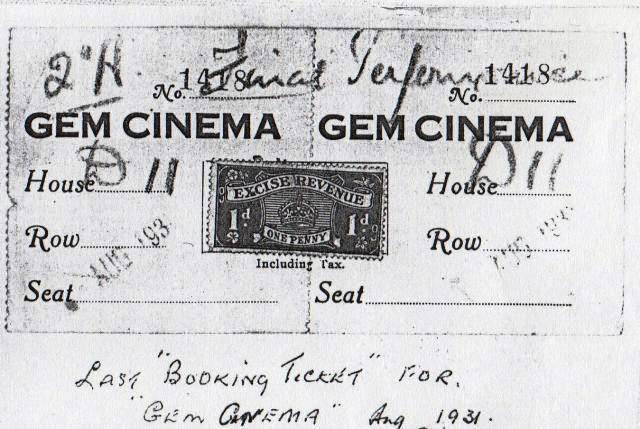
In February 1931, when an application was made to extend the opening hour from 10.30 p.m. to 10.45 p.m., the Gem was described as shabby by the police, and the clerk to the magistrates warned that unless the cinema was put into a presentable condition the licence might be in jeopardy. In October Harold Wright, the then licencee, applied for a dramatic, music and dancing licence in respect of the cinema. "The Talkies have come into vogue", he said, "and as the place is not large enough to install a talkie apparatus, we intend to run performances by dramatic societies and concert parties". The new policy began on Monday 20 October 1931. Perhaps at this stage the plans for a mini Plaza at the Union Rooms caused something of a panic. The building was later used as a meeting hall.
